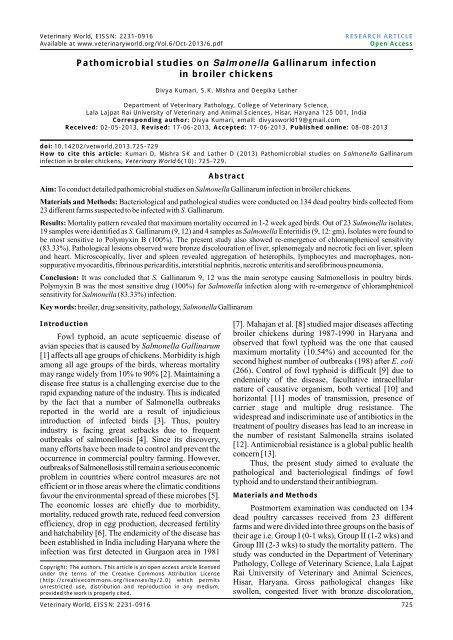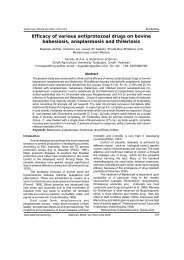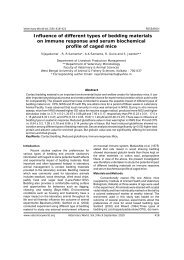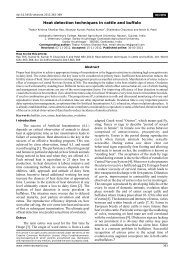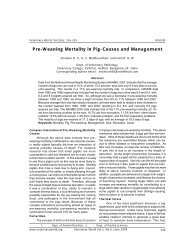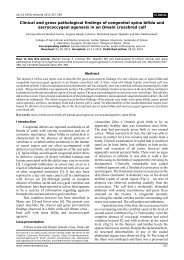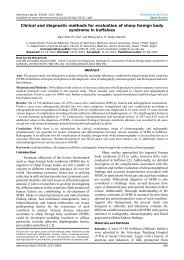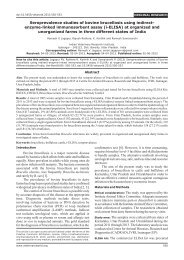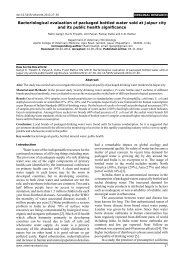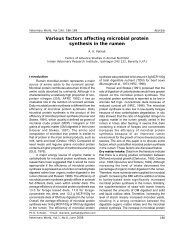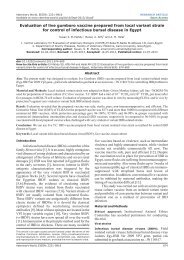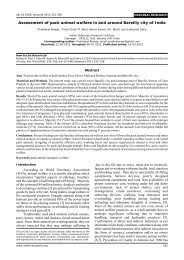Pathomicrobial studies on Salmonella Gallinarum ... - Veterinary World
Pathomicrobial studies on Salmonella Gallinarum ... - Veterinary World
Pathomicrobial studies on Salmonella Gallinarum ... - Veterinary World
Create successful ePaper yourself
Turn your PDF publications into a flip-book with our unique Google optimized e-Paper software.
<strong>Veterinary</strong> <strong>World</strong>, EISSN: 2231-0916Available at www.veterinaryworld.org/Vol.6/Oct-2013/6.pdfRESEARCH ARTICLEOpen Access<str<strong>on</strong>g>Pathomicrobial</str<strong>on</strong>g> <str<strong>on</strong>g>studies</str<strong>on</strong>g> <strong>on</strong> Salm<strong>on</strong>ella <strong>Gallinarum</strong> infecti<strong>on</strong>in broiler chickensDivya Kumari, S.K. Mishra and Deepika LatherDepartment of <strong>Veterinary</strong> Pathology, College of <strong>Veterinary</strong> Science,Lala Lajpat Rai University of <strong>Veterinary</strong> and Animal Sciences, Hisar, Haryana 125 001, IndiaCorresp<strong>on</strong>ding author: Divya Kumari, email: divyasworld19@gmail.comReceived: 02-05-2013, Revised: 17-06-2013, Accepted: 17-06-2013, Published <strong>on</strong>line: 08-08-2013doi: 10.14202/vetworld.2013.725-729How to cite this article: Kumari D, Mishra SK and Lather D (2013) <str<strong>on</strong>g>Pathomicrobial</str<strong>on</strong>g> <str<strong>on</strong>g>studies</str<strong>on</strong>g> <strong>on</strong> Salm<strong>on</strong>ella <strong>Gallinarum</strong>infecti<strong>on</strong> in broiler chickens, <strong>Veterinary</strong> <strong>World</strong> 6(10): 725-729.AbstractAim: To c<strong>on</strong>duct detailed pathomicrobial <str<strong>on</strong>g>studies</str<strong>on</strong>g> <strong>on</strong> Salm<strong>on</strong>ella <strong>Gallinarum</strong> infecti<strong>on</strong> in broiler chickens.Materials and Methods: Bacteriological and pathological <str<strong>on</strong>g>studies</str<strong>on</strong>g> were c<strong>on</strong>ducted <strong>on</strong> 134 dead poultry birds collected from23 different farms suspected to be infected with S. <strong>Gallinarum</strong>.Results: Mortality pattern revealed that maximum mortality occurred in 1-2 week aged birds. Out of 23 Salm<strong>on</strong>ella isolates,19 samples were identified as S. <strong>Gallinarum</strong> (9, 12) and 4 samples as Salm<strong>on</strong>ella Enteritidis (9, 12: gm). Isolates were found tobe most sensitive to Polymyxin B (100%). The present study also showed re-emergence of chloramphenicol sensitivity(83.33%). Pathological lesi<strong>on</strong>s observed were br<strong>on</strong>ze discolourati<strong>on</strong> of liver, splenomegaly and necrotic foci <strong>on</strong> liver, spleenand heart. Microscopically, liver and spleen revealed aggregati<strong>on</strong> of heterophils, lymphocytes and macrophages, n<strong>on</strong>suppurativemyocarditis, fibrinous pericarditis, interstitial nephritis, necrotic enteritis and serofibrinous pneum<strong>on</strong>ia.C<strong>on</strong>clusi<strong>on</strong>: It was c<strong>on</strong>cluded that S. <strong>Gallinarum</strong> 9, 12 was the main serotype causing Salm<strong>on</strong>ellosis in poultry birds.Polymyxin B was the most sensitive drug (100%) for Salm<strong>on</strong>ella infecti<strong>on</strong> al<strong>on</strong>g with re-emergence of chloramphenicolsensitivity for Salm<strong>on</strong>ella (83.33%) infecti<strong>on</strong>.Key words: broiler, drug sensitivity, pathology, Salm<strong>on</strong>ella <strong>Gallinarum</strong>Introducti<strong>on</strong>[7]. Mahajan et al. [8] studied major diseases affectingFowl typhoid, an acute septicaemic disease of broiler chickens during 1987-1990 in Haryana andavian species that is caused by Salm<strong>on</strong>ella <strong>Gallinarum</strong> observed that fowl typhoid was the <strong>on</strong>e that caused[1] affects all age groups of chickens. Morbidity is highmaximum mortality (10.54%) and accounted for theam<strong>on</strong>g all age groups of the birds, whereas mortalitysec<strong>on</strong>d highest number of outbreaks (198) after E. colimay range widely from 10% to 90% [2]. Maintaining a(266). C<strong>on</strong>trol of fowl typhoid is difficult [9] due todisease free status is a challenging exercise due to theendemicity of the disease, facultative intracellularrapid expanding nature of the industry. This is indicatednature of causative organism, both vertical [10] andby the fact that a number of Salm<strong>on</strong>ella outbreakshoriz<strong>on</strong>tal [11] modes of transmissi<strong>on</strong>, presence ofreported in the world are a result of injudiciouscarrier stage and multiple drug resistance. Theintroducti<strong>on</strong> of infected birds [3]. Thus, poultrywidespread and indiscriminate use of antibiotics in theindustry is facing great setbacks due to frequenttreatment of poultry diseases has lead to an increase inthe number of resistant Salm<strong>on</strong>ella strains isolatedoutbreaks of salm<strong>on</strong>ellosis [4]. Since its discovery,[12]. Antimicrobial resistance is a global public healthmany efforts have been made to c<strong>on</strong>trol and prevent thec<strong>on</strong>cern [13].occurrence in commercial poultry farming. However,Thus, the present study aimed to evaluate theoutbreaks of Salm<strong>on</strong>ellosis still remain a serious ec<strong>on</strong>omicpathological and bacteriological findings of fowlproblem in countries where c<strong>on</strong>trol measures are nottyphoid and to understand their antibiogram.efficient or in those areas where the climatic c<strong>on</strong>diti<strong>on</strong>sfavour the envir<strong>on</strong>mental spread of these microbes [5]. Materials and MethodsThe ec<strong>on</strong>omic losses are chiefly due to morbidity, Postmortem examinati<strong>on</strong> was c<strong>on</strong>ducted <strong>on</strong> 134mortality, reduced growth rate, reduced feed c<strong>on</strong>versi<strong>on</strong> dead poultry carcasses received from 23 differentefficiency, drop in egg producti<strong>on</strong>, decreased fertility farms and were divided into three groups <strong>on</strong> the basis ofand hatchability [6]. The endemicity of the disease has their age i.e. Group I (0-1 wks), Group II (1-2 wks) andbeen established in India including Haryana where the Group III (2-3 wks) to study the mortality pattern. Theinfecti<strong>on</strong> was first detected in Gurga<strong>on</strong> area in 1981 study was c<strong>on</strong>ducted in the Department of <strong>Veterinary</strong>Pathology, College of <strong>Veterinary</strong> Science, Lala LajpatRai University of <strong>Veterinary</strong> and Animal Sciences,Hisar, Haryana. Gross pathological changes likeswollen, c<strong>on</strong>gested liver with br<strong>on</strong>ze discolorati<strong>on</strong>,Copyright: The authors. This article is an open access article licensedunder the terms of the Creative Comm<strong>on</strong>s Attributi<strong>on</strong> License(http://creativecomm<strong>on</strong>s.org/licenses/by/2.0) which permitsunrestricted use, distributi<strong>on</strong> and reproducti<strong>on</strong> in any medium,provided the work is properly cited.<strong>Veterinary</strong> <strong>World</strong>, EISSN: 2231-0916 725
Available at www.veterinaryworld.org/Vol.6/Oct-2013/6.pdfTable-1. In-vitro chemotherapeutic drug sensitivity (% sensitivity) of Salm<strong>on</strong>ella spp. isolated from visceral organs andheart bloodDrug% sensitivity to Salm<strong>on</strong>ella spp.Amikacin 83.33Ampicillin 75.00Amoxycillin 91.66Cefixime 83.33Chloramphenicol 83.33Doxycycline Hydrochloride 91.66Ciprofloxacin 66.66Furox<strong>on</strong>e 83.33Cefoperaz<strong>on</strong>e 75.00Colistin 83.33Co-Trimoxazole 75.00Enrofloxacin 91.66Gentamycin 66.66Amoxycillin & Sulbactam 91.66Nalidixic acid 16.66Amoxyclav 75.00Ofloxacin 75.00Polymyxin B 100Streptomycin 75.00Oxytetracycline 83.33Isolati<strong>on</strong> and characterizati<strong>on</strong>: Heart blood and tissuesamples collected aseptically were inoculated inoRappaport enrichment medium and incubated at 43 Cfor 24 hours. After 24 hours, inoculati<strong>on</strong> was d<strong>on</strong>e <strong>on</strong>MacC<strong>on</strong>key's Lactose agar (MLA), Brilliant Greenagar (BGA), Salm<strong>on</strong>ella Shigella Agar (SSA) andXylose Lysine Deoxycholate agar (XLD). Primaryidentificati<strong>on</strong> of the growth was d<strong>on</strong>e by col<strong>on</strong>ymorphology and Gram's staining. The pure cultureswere subjected to various biochemical tests for furthercharacterizati<strong>on</strong> [14]. Isolates were subjected to invitrodrug sensitivity test using 20 antimicrobials by thedisc diffusi<strong>on</strong> method as suggested by Bauer et al. [15].Serotyping of the isolates: Organisms positive forSalm<strong>on</strong>ella spp. were sent to Nati<strong>on</strong>al Salm<strong>on</strong>ella andEscherichia Centre (NSEC), Central ResearchInstitute, Kasauli, Himachal Pradesh, India for furtherserotyping.Pathological findings: All the organs and tissues of thecarcasses were examined critically for gross changesduring postmortem examinati<strong>on</strong> and the lesi<strong>on</strong>sobserved were recorded. The formalin fixed tissueswere processed and stained using routine haematoxylinand eosin staining method [16].Results and Discussi<strong>on</strong>enlarged spleen, multiple necrotic foci <strong>on</strong> spleen andliver; and multiple white nodules <strong>on</strong> heart with distorti<strong>on</strong>in shape suggest that carcass can be suspected to beinfected with Salm<strong>on</strong>ella <strong>Gallinarum</strong>. Clinical signsand history regarding vaccinati<strong>on</strong> was collected fromowners which showed that infected birds exhibitedacute illness, ruffled feathers, inappetance, difficulty inbreathing, reluctance to move and watery to mucoidyellowish diarrhoea which further c<strong>on</strong>firms ourassumpti<strong>on</strong> of Salm<strong>on</strong>ellla <strong>Gallinarum</strong> infecti<strong>on</strong>. Thebirds were vaccinated against Marek's disease (<strong>on</strong> 0day), Newcastle disease (at 5 days and 22 days) andInfectious bursal disease (at 14 days) and weremaintained under standard managemental practices.During postmortem examinati<strong>on</strong>, blood from thehearts of carcasses was collected with help of sterilizedsyringes for bacteriological examinati<strong>on</strong>. Differentorgans were examined critically for gross lesi<strong>on</strong>s andwere collected under aseptic c<strong>on</strong>diti<strong>on</strong>s for bacterio-logical isolati<strong>on</strong>s. Tissue pieces of heart, liver, lung,spleen, intestine, pancreas, proventriculus, bursa offabricius and kidney were collected in a 10% bufferedformalin for histopathological examinati<strong>on</strong>.Mortality pattern: Age-wise mortality due to Salm<strong>on</strong>ellaspp. revealed maximum mortality in group II followedby group I (Fig. 1). These results are in agreement withprevious reports [17]. It is likely due to the fact thatchicks are not fully immunocompetent when they arebelow 2 weeks of age because of a lower percentage ofCD4+CD8- in the thymus; CD4-CD8+ andCD4+CD8+ in the spleen [18] as well as due to absenceof protecti<strong>on</strong> from maternal antibodies at 1-2 weeks ofage.Figure-1. Age-wise distributi<strong>on</strong> of mortality (%) in poultry due toSalm<strong>on</strong>ella infecti<strong>on</strong>Salm<strong>on</strong>ella characterizati<strong>on</strong>: Out of 23 Salm<strong>on</strong>ellaisolates sent for serotyping, 19 samples were identifiedas Salm<strong>on</strong>ella <strong>Gallinarum</strong> (9,12) and 4 samples asSalm<strong>on</strong>ella Enteritidis (9,12: gm). Salm<strong>on</strong>ella<strong>Gallinarum</strong> and Salm<strong>on</strong>ella Enteritidis share acomm<strong>on</strong> immunodominant surface antigen (O9), such<strong>Veterinary</strong> <strong>World</strong>, EISSN: 2231-0916 726
Available at www.veterinaryworld.org/Vol.6/Oct-2013/6.pdfFigure-2. Br<strong>on</strong>ze discolorati<strong>on</strong> withenlargement of liver (Salm<strong>on</strong>ella <strong>Gallinarum</strong>infecti<strong>on</strong>)Figure-3. Liver: Showing large area of coagulativenecrosis, surrounded by leucocytes.(Salm<strong>on</strong>ella <strong>Gallinarum</strong> infecti<strong>on</strong>) H & E x 33Figure-4. Necrotic nodule <strong>on</strong> heart(Salm<strong>on</strong>ella <strong>Gallinarum</strong> infecti<strong>on</strong>)Figure-5. Heart: Severe myocarditis withfragmented myocardial muscle fibres al<strong>on</strong>gwith infiltrati<strong>on</strong> of lymphocytes and heterophils(Salm<strong>on</strong>ella <strong>Gallinarum</strong> infecti<strong>on</strong>)H & E x 33Liver: Grossly, the liver appeared swollen, c<strong>on</strong>gestedal<strong>on</strong>g with br<strong>on</strong>ze discolorati<strong>on</strong> (Fig.2). Microscopi-cally, hepatitis characterized by leucocytic infiltrati<strong>on</strong>at perivascular areas al<strong>on</strong>g with hydropic vacuolati<strong>on</strong>in hepatocytes, multiple necrotic foci was noticed withKupffer cell hyperplasia. Few areas displayed necrosisof hepatocytes, with focal aggregati<strong>on</strong> of heterophils,lymphocytes and macrophages (Fig.3). Similardegenerative, necrotic and infiltrative lesi<strong>on</strong>s havebeen reported earlier [28-30].that S. Enteritidis preinfected poultry were protectedagainst col<strong>on</strong>izati<strong>on</strong> with Salm<strong>on</strong>ella <strong>Gallinarum</strong>. Thisshows that coexistence of S. <strong>Gallinarum</strong> and S.Enteritidis in poultry prompts competiti<strong>on</strong> as a result ofthe shared immunodominant O9-antigen whichgenerates cross-immunity [19]. Several published<str<strong>on</strong>g>studies</str<strong>on</strong>g> in other countries have reported antimicrobialresistance in Salm<strong>on</strong>ella [20-22]. Antibiogram patternsof isolates in the present investigati<strong>on</strong> showed varyingdegree of sensitivity to the chemotherapeutic agentstested (Table-1). Salm<strong>on</strong>ella spp. were found to bemost sensitive to polymyxin B (100%) which was inagreement with the findings of Kavitha et al. [23]followed by amoxicillin, amoxicillin sublactam,enrofloxacin, doxycycline hydrochloride (91.66%). Inour study, Salm<strong>on</strong>ella spp. was found to be resistant t<strong>on</strong>alidixic acid (84%). The Salm<strong>on</strong>ella isolates in Indiafrom 1996-99 and 2001 were reported to be 100%chloramphenical sensitive and sensitivity of 79% wasalso reported in 2000 [24]. The present study alsoobserved chloramphenical sensitivity of around83.33%; similar findings have been reported byTaddele et al. [25]. This re-emergence of chloramphenicolsensitivity could be attributed to the limited use of thisantimicrobial during the last decade in India [26].Highest sensitivity of Salm<strong>on</strong>ella to polymyxin Bmight be due to the cati<strong>on</strong>ic acti<strong>on</strong> of polymyxin B <strong>on</strong>cell membrane of susceptible bacteria where it causesFigure-6. Spleen: Showing sec<strong>on</strong>daryfollicles and multiple necrotic areas(Salm<strong>on</strong>ella <strong>Gallinarum</strong> infecti<strong>on</strong>) H & E x 33Figure-7. Intestine: Necrotic enteritischaracterized by presence of necrotic massal<strong>on</strong>g with desquamated epithelial cells andleucocytes in the lumen (Salm<strong>on</strong>ella<strong>Gallinarum</strong> infecti<strong>on</strong>) H & E x 33bleb formati<strong>on</strong> <strong>on</strong> cell wall and morphological changesin the cytoplasm [27]. The varying degree of resistanceand sensitivity to chemotherapeutic drugs has alsobeen reported by Sujatha et al. [28]. High prevalence ofnalidixic acid resistance am<strong>on</strong>g Salm<strong>on</strong>ella <strong>Gallinarum</strong>was also reported by previous workers [25]. In thepresent study, the resistance to above menti<strong>on</strong>edantibiotics might be attributed mainly to the frequentand indiscriminate use of these antibiotics fortreatment, prophylaxis and as feed supplements.Pathological <str<strong>on</strong>g>studies</str<strong>on</strong>g>: During necropsy examinati<strong>on</strong>carcasses of the Salm<strong>on</strong>ella infected birds appearedjaundiced.Heart: The cardiac lesi<strong>on</strong>s c<strong>on</strong>sisted of mild tomoderate c<strong>on</strong>gesti<strong>on</strong> and hemorrhage. In few cases,multiple white nodules with distorted shapes wereobserved <strong>on</strong> the heart (Fig.4). Histopathologically<strong>Veterinary</strong> <strong>World</strong>, EISSN: 2231-0916 727
severe degenerati<strong>on</strong> and fragmentati<strong>on</strong> of myocardialmuscle fibres (n<strong>on</strong> suppurative myocarditis) was observedin most of the cases with leucocytic infiltrati<strong>on</strong> (Fig.5).Fibrinous pericarditis with infiltrati<strong>on</strong> of heterophils,lymphocytes and macrophages was also observed insome cases. Similar findings have been reported byMsoffe et al., [31].Available at www.veterinaryworld.org/Vol.6/Oct-2013/6.pdfbursal follicles al<strong>on</strong>g with interfollicular fibrosis. Lossof lymphoid tissue from follicles and degenerati<strong>on</strong> ofbursa of fabricius has been reported by Garren andBarber [33]. These workers suggested that changes inbursa resulted from adverse physiological c<strong>on</strong>diti<strong>on</strong>slike anorexia, dehydrati<strong>on</strong>, anaemia etc.Poventriculus: The proventriculitis was characterizedby c<strong>on</strong>gesti<strong>on</strong>, mucosal degenerati<strong>on</strong> al<strong>on</strong>g withinfiltrati<strong>on</strong> of heterophils and lymphocytes in mucosaextending up to serosal layer in some cases. Mucosalglands were atrophied due to leucocytic infiltrati<strong>on</strong> in afew cases. There was degenerati<strong>on</strong> of proventricularglands and lumen was filled with detached epithelialmass. The microscopic changes in proventriculus wereSpleen: There was splenomegaly al<strong>on</strong>g with multiplenecrotic foci <strong>on</strong> the surface. Microscopically, there wassevere depleti<strong>on</strong> of lymphoid cells in white pulp al<strong>on</strong>gwith reticuloendothelial cell hyperplasia (Fig.6).Besides this in a few cases, a number of sec<strong>on</strong>darylymphoid follicles was noticed. Similar histopathologicalchanges including focal necrosis, reticuloendothelial cell hyperplasia and sec<strong>on</strong>dary lymphoid similar to those reported by Rao et al. [34].follicles have been reported by Shivaprasad [30].C<strong>on</strong>clusi<strong>on</strong>Intestine: Grossly, catarrhal enteritis was evident insome cases characterized by thick slimy mucusexudate <strong>on</strong> mucosal surfaces in the lumen of intestine.Histopathologically there was desquamati<strong>on</strong> ofmucosal epithelium resulting in denuded villi andlumen was filled with necrotic mass (Fig.7). Secretoryglands were atrophied at some places due to severeinfiltrati<strong>on</strong> of heterophils and m<strong>on</strong><strong>on</strong>uclear cells.Goblet cell hyperplasia and focal fibroblasticc<strong>on</strong>nective tissue proliferati<strong>on</strong> between the glands waspresent in many cases. Giannella [32] reported thatSalm<strong>on</strong>ella induced diarrhoea is multifactorial. The<strong>on</strong>set of fluid secreti<strong>on</strong> is preceded by a massive influxof inflammatory cells leading to release of prostaglandinsthat stimulate intestinal adenylcyclase mediatedfluid secreti<strong>on</strong>.Pancreas: In pancreas, there was mild c<strong>on</strong>gesti<strong>on</strong> andhemorrhages al<strong>on</strong>g with mild degenerative changes.Leucocytic infiltrati<strong>on</strong> in acinar cells and interlobularc<strong>on</strong>nective tissue was present in most of the cases. Thehistopathological changes in affected birds were inc<strong>on</strong>gruence with the observati<strong>on</strong>s of Prasanna et al.[29].Lungs: Lungs were highly c<strong>on</strong>gested with pneum<strong>on</strong>iclesi<strong>on</strong>s in most of the cases. Microscopically moderatec<strong>on</strong>gesti<strong>on</strong> and hemorrhages were observed withpresence of RBCs in the alveoli (red hepatizati<strong>on</strong>). Atplaces, there was presence of serofibrinous exudate inalveoli and interlobular septa. Similar lesi<strong>on</strong>s havebeen reported by Shivprasad [30].S. <strong>Gallinarum</strong> 9, 12 was mainly involved incausing Salm<strong>on</strong>ellosis in poultry birds tested in thepresent study. In some of the cases S. Enteritidis wasalso isolated. Polymyxin B was the most sensitive drug(100%) for treating Salm<strong>on</strong>ella infecti<strong>on</strong>s. Surprisingly,our study also revealed that Salm<strong>on</strong>ella infecti<strong>on</strong>s arealso highly sensitive to chloramphenicol .Recommendati<strong>on</strong>s for farm ownersBecause polymyxin B was found to be the mostsensitive drug for Salm<strong>on</strong>ella infecti<strong>on</strong> in the presentstudy, we recommend the drug for treatment ofsalm<strong>on</strong>ellosis.Authors’ c<strong>on</strong>tributi<strong>on</strong>sDK and SKM participated in the preparati<strong>on</strong> ofexperimental design and the facilities of the research,drafted the manuscript. DL revised the final draft ofmanuscript. All authors read the final manuscript.AcknowledgementsThe authors express their gratitude to the Dean,College of <strong>Veterinary</strong> Science, Lala Lajpat RaiUniversity of <strong>Veterinary</strong> and Animal Sciences, Hissar,Haryana for providing the facilities and fund forc<strong>on</strong>ducting this experiment.Competing interestsThe authors declare that they have no competing interests.References1. Priyantha, M.A.R (2012) An Overview: Vaccinati<strong>on</strong> toKidneys: Grossly, kidneys were enlarged with c<strong>on</strong>trol fowl typhoid in Commercial layers, Sri Lanka.prominent lobulati<strong>on</strong> and necrotic foci <strong>on</strong> the surface. Wayamba Journal of Animal Science, Pp.- 23-25.2. Latife Beyaz, Ayhan Atasver, Fuat Aydin, K. SemihMicroscopically, glomeruli were c<strong>on</strong>tracted al<strong>on</strong>gwith Gumssoy and Secil Abay (2010) Pathological and clinicaldegenerative changes in the renal tubular epithelium. findings and tissue distributi<strong>on</strong> of Salm<strong>on</strong>ella <strong>Gallinarum</strong>Similar degenerative and infiltrative changes in infecti<strong>on</strong> in turkey poults. Turk. J. Vet. Anim. Sci., 34(2): 101-kidneys of birds affected with fowl typhoid have been 110.3. Meeusen, E.N.T., Waker, J., Peter, A., Pastoret, P.P. anddescribed by Shivaprasad [30].Jungersen, G. (2007) Current status of <strong>Veterinary</strong> vaccine.Bursa of fabricius: Grossly, <strong>on</strong>ly mild c<strong>on</strong>gesti<strong>on</strong> was Clinical Microbiology Review. Pp.- 489-510.4. Fatma, A.G., El-Gohary, A.H., El-Bably, M.A. andobserved in bursa of Fabricius. Histopathological Mohamed, A.A. (2012). Vitro antibiotic sensitivity ofchanges include mild depleti<strong>on</strong> of lymphoid tissue in isolated strains of salm<strong>on</strong>ella and E. coli from poultry farm.<strong>Veterinary</strong> <strong>World</strong>, EISSN: 2231-0916 728
Available at www.veterinaryworld.org/Vol.6/Oct-2013/6.pdfCompandium of 7th Int. Sci. C<strong>on</strong>f., Mansoura, 28-30 August. Journal of <strong>Veterinary</strong> Sciences. 2(1): 33-36.Pp.- 191-199.20. Pokharel P, Rai SK, Karki G, Katuwal A, Vitrakoti R. and5. Barrow, P.A. and Freitas Neto, O.C. (2011) Pullorum disease Shrestha SK (2009) Study of enteric fever and antibogram ofand fowl typhoid--new thoughts <strong>on</strong> old diseases: a review. Salm<strong>on</strong>ella isolates at a teaching hospital in KathmanduAvian Pathol. 40 (1): 1-13. Valley. Nepal Med. Coll. J., 11(3): 176-178.6. Mamta, S.K. Mishra, and Deepika Lather (2010) 21. Wei, L.S. and Wee, W. (2011) Antibiogram and heavy metalAmeliorating effect of tulsi (ocimum sanctum) leaf powder resistance pattern of Salm<strong>on</strong>ella spp. Isolated from wild<strong>on</strong> pathology of salm<strong>on</strong>ella gallinarum infecti<strong>on</strong> in broiler Asian Sea Bass (Lates calcalifer) from Tok Bali, Kelantan,chickens. Haryana Vet. 49: 6-10. Malaysia. Jordan J. Biological Sci., 4(3): 125-128.7. An<strong>on</strong> (1980-81) Annual progress report of disease 22. Selvaraj, R., Das, R., Ganguly, S., Ganguli, M., Dhanalainvestigati<strong>on</strong>laboratory, Gurga<strong>on</strong>, Department of <strong>Veterinary</strong> kshmi, S. and Mukhopadhayay, S.K. (2010) Characteri-Public Health and Epidemiology, Haryana Agricultural zati<strong>on</strong> and antibiogram of Salm<strong>on</strong>ella spp. from poultryUniversity, Hisar. specimens. J. Microbiol. Antimicrobials, 2(9): 123-126.8. Mahajan, N.K., Jindal, N. and Kulshrestha, R.C. (1994) 23. Kavitha, R., Chaturvedi, V.K. and Pandey, K.D. (2008)Major broiler diseases in some parts of Haryana. Indian J. Plasmid profile of Salm<strong>on</strong>ella Weltevereden isolates ofAnim. Sci. 64: 1118-1122.lizard and goat origin. Journal of <strong>Veterinary</strong> Public Health,9. S<strong>on</strong>cine, R.A. and Back, A. (2001) Salm<strong>on</strong>ella Enteritidis 6(2): 117-120.em aves: erradicação ou c<strong>on</strong>trole por vacinação. In: 24. Mandal, S., Mandal, M.D. and Pal, N.K. (2004) ReducedC<strong>on</strong>ferência Apinco de Ciência e Tecnologia Avícolas, minimum inhibitory c<strong>on</strong>centrati<strong>on</strong> of chloramphenicol forCampinas. Anais, São Paulo: FACTA, 1: 21-30. Salm<strong>on</strong>ella enterica serovar typhi. Indian J. Med. Sci., 58:10. Paiva, J.B., Penha, F., Anguello, Y.M.S., Siva, M.D., Gardin, 16-23.Y., Resende, F., Berchieri, A. and Sestsi, L. (2009) Efficacy 25. Taddele, M.H., Rathore, R. and Dhama, K. (2012)of several Salm<strong>on</strong>ella vaccinati<strong>on</strong> programme againstAntibiogram assay of Salm<strong>on</strong>ella <strong>Gallinarum</strong> and otherexperimental challenge with Salm<strong>on</strong>ella <strong>Gallinarum</strong> inSalm<strong>on</strong>ella enteric serovars of poultry origin in India. Asiancommercial brown breeder hens. Brazilian Journal ofJ. of Animal and <strong>Veterinary</strong> Advances. 7(4): 309-317.Poultry Science, 11(1): 65-72.26. Mohanty, S., K., Renuka., Sood. S., Das, B.K. and Kapil, A.11. Cox, N.A., Bailey, J.S. and Berrang, M.E. (1996) Extent of(2006) Antibiogram pattern and seas<strong>on</strong>ality of Salm<strong>on</strong>ellaSalm<strong>on</strong>ellae c<strong>on</strong>taminati<strong>on</strong> in breeder hatcheries, Poultryserotypes in north Indian tertiary care hospital. Epidemiol.Science, Champaign, 70: 416-418.Infect., 134: 961-966.12. Enabulele, S.A., Amune, P.O. and Aborisade, W.T. (2010)27. Daugelavicius, R., Bakiene, E. and Bamford, D.H. (2000)Antibiograms of Salm<strong>on</strong>ella isolates from poultry in OviaNorth East local government area Edo State, Nigeria. Agric.Stages of polymyxin B interacti<strong>on</strong> with E. coli cell envelope.Biol. J. North Am., 1(6): 1287-1290.Antimicrobial agents and chemotherapy. 44(11): 2969.13. Ahmed, M.M., Rahman, M.M., Mahbub, K.R. and28. Sujatha, K., Dhanalakshmi, K. and Rao, A.S. (2003)Wahiduzzaman, M. (2011) Characterizati<strong>on</strong> of antibioticIsolati<strong>on</strong> and characterizati<strong>on</strong> of Salm<strong>on</strong>ella <strong>Gallinarum</strong>resistant Salm<strong>on</strong>ella spp isolated from chicken eggs of from chicken. Indian Vet. J. 80: 473-474.Dhaka city. J. Sci. Res., 3: 191-196.29. Prasanna, K., Somvanshi, R. and Paliwal, O.P. (2001)14. Carter, G.R. (1984) Diagnostic procedures in <strong>Veterinary</strong> Experimental fowl typhoid and pullorum disease infecti<strong>on</strong> inthBacteriology and Mycology, 4 edn. Charles C. Thomas, chicken: Histopathological and ultrastructural <str<strong>on</strong>g>studies</str<strong>on</strong>g> ofSpringfield, Illinois, U.S.A.small intestine and liver. Indian J. Vet. Path. 21: 18-20.15. Bauer, A.W., Kirby, W.M.M., Sherris, J.C. and Truck, M. 30. Shivprasad, H L. (2000) Fowl typhoid and Pullorum disease.(1966) Antibiotic susceptibility testing by standardizing Sci Tech. Rev.19: 405-424.single disc method. Am. J. Clin. Path. 45: 493.31. Msoffe, P.L.M., Minga, U.M., Mtambo, M.M.A., Gwakisa,16. Luna L.G. (1968) Manual of histologic staining methods of P.S. and Olsen, J.E. (2006) Differences in resistance tordthe Armed forces Institute of Pathology. 3 edn. Mc Graw hill Salm<strong>on</strong>ella enterica serovar <strong>Gallinarum</strong> infecti<strong>on</strong> am<strong>on</strong>gBook Company, New York.33-37.indigenous local chicken ecotypes in Tanzania. Avian17. Kumar, T., Mahajan, N.K. and Rakha, N.K. (2010) Pathol. 35(4): 270-276.Epidemiology of fowl typhoid in Haryana, India. <strong>World</strong> 32. Giannella, R.A. (1979) Importance of intestinalPoultry Science Journal. 66: 503-510.inflammatory reacti<strong>on</strong> in Salm<strong>on</strong>ella- mediated intestinal18. Erf, G.F, Walter G Bottje, Tina K Bersi (1998) CD4, CD8 and secreti<strong>on</strong>. Infect. Immun. 23: 140-145.TCR defined T-cell subsets in thymus and spleen of 2- and 7- 33. Garren, H.W. and Barber, C.W. (1955) Endocrine andweek old commercial broiler chickens, Vet Immunol lymphatic glands changes occurring in young chickens withImmunopatho, 62(4): 339 - 348.fowl typhoid. Poult. Sci. 34: 1250-1258.19. Lee, Y.J., Kang, M.S., Woo, Y.K., Mo, I.P. and Tak, R.B. 34. Rao, S.B.V., Naraya, D.R., Ramnani and Das, J. (1952)(2001) Competitive exclusi<strong>on</strong> against Salm<strong>on</strong>ella Avian salm<strong>on</strong>ellosis: Studies <strong>on</strong> Salm<strong>on</strong>ella <strong>Gallinarum</strong>.<strong>Gallinarum</strong> of Salm<strong>on</strong>ella Enteritidis infected chickens. Indian J. Vet. Sci. 22: 199-208.********<strong>Veterinary</strong> <strong>World</strong>, EISSN: 2231-0916 729


